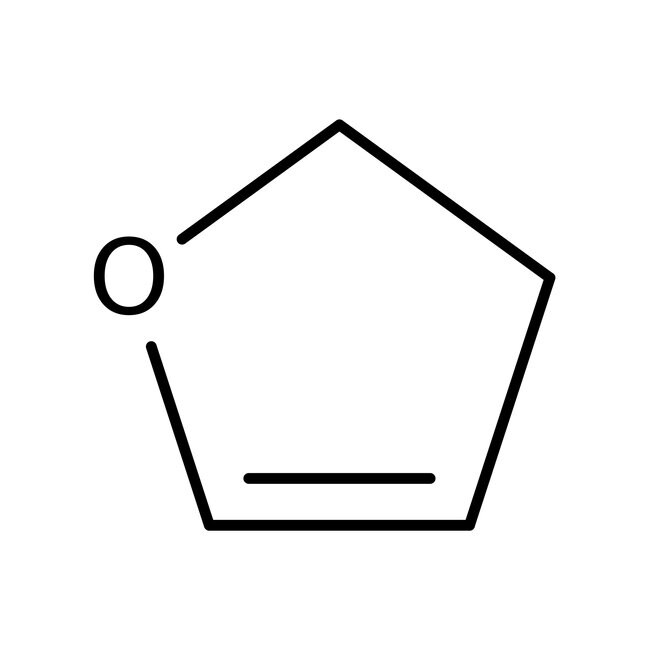Search Thermo Fisher Scientific
Thermo Scientific Chemicals
2,3-Dihydrofuran, 98+%, Thermo Scientific Chemicals
Catalog number B20575.22
also known as B20575-22
Price (USD)/ Each
61.65
Online exclusive
68.10 Save 6.45 (9%)
-
Quantity:
100 g
Price (USD)/ Each
61.65
Online exclusive
68.10 Save 6.45 (9%)
2,3-Dihydrofuran, 98+%, Thermo Scientific Chemicals
Catalog numberB20575.22
Price (USD)/ Each
61.65
Online exclusive
68.10 Save 6.45 (9%)
-
Chemical Identifiers
CAS1191-99-7
IUPAC Name2,3-dihydrofuran
Molecular FormulaC4H6O
InChI KeyJKTCBAGSMQIFNL-UHFFFAOYSA-N
SMILESC1CC=CO1
View more
Specifications Specification Sheet
Specification Sheet
Assay (GC)≥98.0%
FormLiquid
Appearance (Color)Clear colorless to pale yellow
Identification (FTIR)Conforms
Refractive Index1.4220-1.4265 @ 20?C
2,3-Dihydrofuran is a versatile reagent used in lanthanide-catalyzed Diels-Alder reactions with 2-pyrones and in Rh(II)-stabilized cycloadditions with vinylcarbenoids. It is applied for alkylation by active methylene compounds, catalyzed by trans-Dichlorobis(triphenylphosphine)palladium(II). It is also used in the preparation of biologically active compounds such as antitumor agents.
This Thermo Scientific Chemicals brand product was originally part of the Alfa Aesar product portfolio. Some documentation and label information may refer to the legacy brand. The original Alfa Aesar product / item code or SKU reference has not changed as a part of the brand transition to Thermo Scientific Chemicals.
Applications
2,3-Dihydrofuran is a versatile reagent used in lanthanide-catalyzed Diels-Alder reactions with 2-pyrones and in Rh(II)-stabilized cycloadditions with vinylcarbenoids. It is applied for alkylation by active methylene compounds, catalyzed by trans-Dichlorobis(triphenylphosphine)palladium(II). It is also used in the preparation of biologically active compounds such as antitumor agents.
Solubility
Soluble in water at 20°C, 20g/L and chloroform.
Notes
Store away from oxidizing agents and air. Keep the container tightly closed and place it in a cool, dry and well ventilated condition. Protect from heat. Keep it refrigerated.
2,3-Dihydrofuran is a versatile reagent used in lanthanide-catalyzed Diels-Alder reactions with 2-pyrones and in Rh(II)-stabilized cycloadditions with vinylcarbenoids. It is applied for alkylation by active methylene compounds, catalyzed by trans-Dichlorobis(triphenylphosphine)palladium(II). It is also used in the preparation of biologically active compounds such as antitumor agents.
Solubility
Soluble in water at 20°C, 20g/L and chloroform.
Notes
Store away from oxidizing agents and air. Keep the container tightly closed and place it in a cool, dry and well ventilated condition. Protect from heat. Keep it refrigerated.
RUO – Research Use Only
General References:
- Ulrike Kohlweyer, et al. Tetrahydrofuran degradation by a newly isolated culture of Pseudonocardia sp. strain K1.FEMS Microbiol. Lett.2000,186301-306.
- Fumiyuki Ozawa, et al. Catalytic asymmetric arylation of 2,3-dihydrofuran with aryl triflates.J. Am. Chem. Soc.,1991,113(4), 1417-1419.
- For lithiation at the 5-position, see: Tetrahedron Lett., 4187 (1977); Org. Synth. Coll., 9, 530 (1998). For alkylation by active methylene compounds, catalyzed by trans-Dichlorobis(triphenyl phosphine) palladium(II) , 10491, see: J. Org. Chem., 47, 2812 (1982). For catalytic asymmetric arylation, see: J. Am. Chem. Soc., 113, 1417 (1991); Pure Appl. Chem., 64, 421 (1992).
- Forms tetrahydrofuranyl esters (acyl hemiacetals) with carboxylic acids. These react with Grignard reagents to give good yields of ketones with minimal enolization or double addition (tertiary alcohol formation). The utility of other acyl hemiacetals as ketone precursors has also been studied: J. Org. Chem., 61, 6071 (1996):

